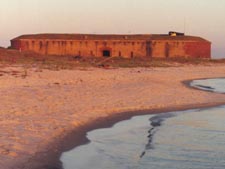-
Ship Island
Ship Island is the name for two
barrier islands off the Gulf coast of Mississippi, which lies in the
Gulf Islands National Seashore, and had been one island but
hurricane Camille split the island into two separate islands, east
and west, in 1969. The island was the only deep water harbor between
Mobile Bay, Alabama and the Mississippi River delta area; serving as
a wonderful anchorage for all kinds of ships that brought soldiers,
explorers, sailors, pirates, colonists, defenders and invaders since
the discovery of it in 1699 by French explorer Pierre Le Moyne
d'Iberville. Pierre then used the island as a base to find the mouth
of the mighty Mississippi River, and it later became the point where
French colonists came. In 1702, it was named Ship Island because of
its portage and became the main port for European colonists from
1720 until 1724. After the Seven Years War ended in the mid 1700s,
the island became the possession of Great Britain, and after the
American Revolution, in 1783, the Brits gave the island to Spain. It
became part of the United States when the Louisiana Purchase was
finished in 1810. Then in 1812, when the war with Britain again
started, Admiral Sir Alexander Cochrane anchored some 50 ships
between Ship Island and Cat Island, and landed 7500 troops getting
ready to fight the Battle of New Orleans; with this island being
used to launch the British troops. In 1849, the US Navy came to Ship
Island to make sure that there weren't any assemblies of mercenaries
preparing for the invasion of Cuba and in 1853, the island got its
first brick and mortar lighthouse. In 1858, the state gave the
island to the United States and Congress voted to build
state-of-the-art masonry fortifications at many strategic locales
along the Atlantic and Gulf coastlines, which included Ship Island.
In 1859, they began to build Fort Massachusetts, but the Civil War
stopped them, although it did become a prison for Confederate POWs
and base for the US Second Regiment, which was made up of Louisiana
Native Guards under the leadership of Colonel Nathan W. Daniels,
becoming one of the first African-American combat units in the union
to fight in the Civil War. On July 9, 1861, there was a 20 minute
cannon exchange between the Confederates and the USS Massachusetts;
and that is why the name was changed to Fort Massachusetts in 1862.
It was finally finished in 1866. In 1880, it was named the first
quarantine station, but the fort closed in 1903, and the station
placed in reserve status until 1916. In 1886, a wooden lighthouse
was built to replace the brick one that had been damaged severely by
the waves and in WWII, the Coast Guard used the island for anti-sub
beach patrols. In 1942, the army used the quarantine station as a
recreation base, and so did Keesler Air Force base in 1955. Then, in
1969, Camille came ashore with 30 foot waves in the tidal surge that
cut that island in two, thus forming East Island and West Island.
Today, East Island is mostly vegetation with some wildlife, and the
West Island is used for recreation and a tourist destination. In
1972, the wooden lighthouse was accidently burned down by campers,
and in 1998, hurricane Georges swept a mile of East Island away. In
2005, Katrina nearly sunk the East Ship Island, but it was the west
that received the brunt of it, as the visitor center was washed
away, as well as the pier, boardwalk and employee facilities.
|

